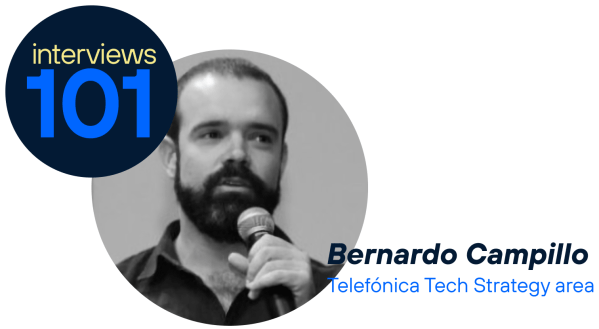What does your job at Telefónica involve?
My job at Telefónica involves designing development requirements for the HADA application, an E2E diagnostic tool designed to identify and solve problems that mass-market customers may experience with their services.
In Argentina, HADA provides comprehensive support for services such as broadband, mobile telephony and TV. This solution, developed and evolved in-house, is used in all our service channels, from digital platforms to traditional ones such as call centres and IVR.
It is a role that combines technology and a focus on the customer experience, contributing to the continuous improvement of the quality of our services.
What does a backend developer do and what are their responsibilities?
A backend developer is responsible for building and maintaining the non-visible part of an application or system, managing everything that happens on the server. Their work ensures that applications are efficient, secure and scalable.
They also understand how the business works, which allows them to offer precise solutions when developing the necessary code. Their main objective is to implement functionalities that ensure the correct performance of the system.
What does it take to become a backend developer?
To become a backend developer, it is essential to combine technical knowledge, practice and experience in programming languages oriented to software development. A key aspect is to understand the architecture of the application to be built, which allows designing efficient solutions.
The main objective is to implement the required functionality, but also to optimise its execution to ensure that processes are fast, accurate and scalable.
What are the most commonly used programming languages for this professional profile?
There are many programming languages for backend development. At Telefónica, for example, Java and C# are widely used. Both are well-established languages that have evolved over time and offer the robustness needed to meet the company’s needs.
In addition, they have a large group of programmers capable of interpreting and working with their code.
On the other hand, more recent languages such as Python are also gaining popularity due to their versatility and large community. However, in my experience, I have not yet seen it used frequently within Telefónica.
What skills are essential for a backend developer?
Backend development is constantly evolving, making it essential to keep up to date with new technologies, tools and best practices. Programming languages are regularly updated to be more robust, secure and user-friendly, making the programmer’s task easier.
For their part, IDEs (Integrated Development Environments) are also advancing, incorporating new functionalities and adapting to more intelligent and predictive environments. This significantly improves the development experience and productivity.
A key change in recent years has been the focus on how software is developed. Previously, the waterfall model was used, where the entire project was planned and developed in large stages.
Now, an agile methodology such as Scrum is preferred, which allows small and constant changes to be made to reach the final solution. This approach implies an important paradigm shift, as developers must adapt quickly to new requirements according to business needs.
Furthermore, planning continuous improvement sprints is key to meeting short-term objectives, which represents a great challenge for both programmers and designers. This flexibility and adaptability are essential in today’s development environment.
What are the main security threats faced by someone working as a backend developer?
A backend developer faces various security threats that can compromise both the data and the system. Among the most common risks are denial of service (DDoS) attacks or malicious code injection.
However, the biggest challenge lies in protecting the sensitive data managed by the backend, as it is often private and business-critical information that cannot be exposed to third parties.
For this reason, many companies have areas specialising in cybersecurity and data protection. At Telefónica, for example, these areas constantly evaluate us to prevent vulnerabilities in our applications.
They also provide us with tools to test our code and apply best security practices, ensuring that the systems are robust and reliable.
How is a frontend developer different from a backend developer?
As the name suggests, a frontend developer focuses mainly on the user experience (UX), while the backend developer is responsible for ensuring that the actions within the system work correctly. Both roles work together to achieve optimal functionality for the user, but each prioritises their specific area.
Nowadays, coordination between the two is much more fluid, but it wasn’t always like that. I remember a few years ago, when they started to divide the tasks into frontend and backend, that it wasn’t easy to reach agreements.
A classic example was the case of round buttons: initially, buttons were square because the technologies of the time limited them. However, with the rise of web applications, users began to prefer round buttons, which generated conflicts between teams.
Fortunately, languages and tools have evolved to integrate both functionality and user experience, allowing both worlds to work in harmony and better adapt to the needs of modern software.
Who do you consider to be an excellent employee at Telefónica?
Hmm, I’ll pass on this question. I couldn’t choose just one person as excellent in their job. Telefónica has given me the privilege of sharing the pitch with true professionals, people with impressive knowledge and unrivalled commitment.
For me, all of us who work at Telefónica are excellent. A true family of Telefónica employees. We pull together every day to improve the experience and quality of our products.
In this team there are players who stand out in each position: some are born goal scorers, others are last-minute saviours, and there are also those who cover the whole field, always ready for whatever is needed.
I have learnt a lot from each of them, and that fills me with pride. We are a team that not only plays to win, but also knows how to adapt to the game. Few technology companies have managed to absorb the dizzying changes in technological advances the way Telefónica has in recent years.












